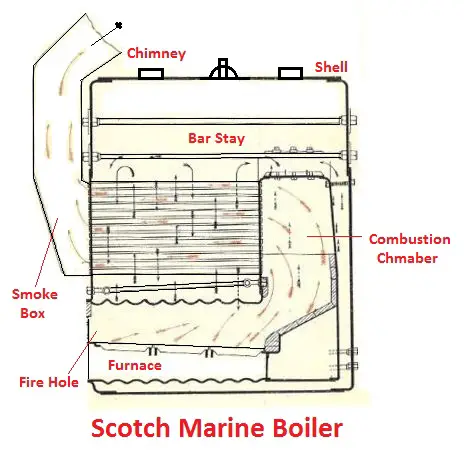Scotch Marine Boiler
The Scotch marine boiler is a usually common boiler used on ships in marine works. This boiler is a type of fire-tube boiler. The marine steam boilers of the scotch or tank-type are used marine for marine works, particularly, due to their compactness, efficiency in operation and their ability to use any type of water. It does not require a brickwork setting and external flues.
Types of Scotch Marine Boiler
The following are the main two types of Scotch Marine Boiler:
- Single-ended Scotch marine boiler
- Double-ended Scotch marine boiler
1. Single-Ended Scotch Marine Boiler
In this boiler, it consists of a circular boiler shell of a large diameter and a short length. The single-ended scotch boiler has a length of up to 3.5 meters. It is consists of one to four furnaces and these furnaces enter from the front end of the boiler. The Scotch boiler was a very common marine boiler, which is used in steamships from many countries.
2. Double-Ended Scotch Marine Boiler
In older double-ended Scotch marine boilers usually had vertical Galloway tubes manufactured into the combustion chamber. They were meant to promote the circulation of water in the boiler and thus contribute to reducing stress in the material. The boiler has a length of up to 6.5 meters. In a double-ended Scotch marine boiler, the furnaces are present at either end of it. And the number of furnaces changes from 2 to 4 at each end.
Read also: Cochran Boiler: Parts, Working, Advantages, Mountings and More
Parts of a Scotch Marine Boiler
The following are important construction parts of Scotch marine boiler:
- Furnace
- Combustion chamber
- Smokebox
- Chimney
- Boiler shell
1. Furnace
It is the space, above the grate and below the boiler, It is employed to burn solid fuel inside the boiler. A single-ended boiler is fired with four furnaces. The furnaces are usually corrugated for strength. In type this boiler, each furnace has its own combustion chamber.
2. Combustion Chamber
It is the space, commonly below the boiler shell, meant for burning fuel in order to generate steam from the water held in the shell. The combustion chamber consists of fine plates, which need to be staying i.e. top plate, backplate, two side plates and tube plate.
3. Smoke Box
The smoking box has several smoke tubes placed horizontally and attaches the combustion chamber to the chimney. The smoke passes through these smoke tubes and eventually enters into the chimney.
4. Chimney
The chimney It is used to drain out the smoke and burnt gases from the boiler. The flue gases are released into the atmosphere by means of the chimney.
5. Boiler Shell
It is made up of steel plates bent into a cylindrical form and riveted or welded together. The boiler shell should have enough ability to contain water and steam. This protects the inner parts of the boiler. All the necessary fittings of the boiler are adjusted on the boiler shell.
Working of Scotch Marine Boiler
It has a drum of diameter from 2-5 to 3-5 meters placed horizontally. These steam boilers may be single-ended or double-ended. the length of a single steam boiler may be up to 3-5 meters while for double-ended up to 6-5 meters. A single-ended boiler has one to four furnace which enters from the front end of the boiler. A double-ended boiler has furnaces on both of its ends and may have furnace from two to four in each end.

A single-ended boiler is fired by four furnaces as shown in the figure. The furnaces are generally corrugated for strength. Each furnace has its own combustion chamber. There is fine flat plate in the combustion chamber, which requires staying i.e., the top plate, backplate, two side plates and the tube plate.
There are a number of smoke tubes placed horizontally and connect the combustion chamber to the chimney. The front and back plates of the shell are strengthened by longitudinal stays.
The combustion chamber walls from the best heating surface. The furnace tubes, smoke tubes and the combustion chamber, all being surrounded by water, give a very large heating surface area in proportion to the cubical size of the boiler.
The water circulates around the smokebox. The level of water is maintained a little above the combustion chamber. The flue gases, from the combustion chamber, are forwarded by draught through the smoke tubes, and finally up the chimney. The smokebox is provided with a door for cleaning the tubes and smokebox.
Advantages of Scotch Marine Boiler
- It is small in size.
- The boiler has the capacity to operate in any type of water.
- This boiler has great efficiency in operation.
- This Boiler does not require a brickwork setting and external flues.
Disadvantages of Scotch Marine Boiler
- More floor area is required for a given output.
- Load variations cannot be easily controlled.
- It is used in small power plants.
- The rate of steam formation and steam quality are not much better than water tube boilers for suitable power generation.
Application of Scotch Marine Boiler
- This boiler is commonly used in marine works. The reason for this is its compactness, efficiency in operation, and ability to operate in any type of water.
- This boiler is used on ships.
FAQ
In this boiler, hot gases flow through the set of tubes within a water tank. It is similar to Lancashire boiler, which uses multiple furnaces to achieve greater heating area for a given furnace capacity.
Single-ended Scotch marine boiler
Double-ended Scotch marine boiler
Scotch marine boiler can operate in any type of water and are in usually small in size.
That’s it, thanks for reading. If you have any questions about “Scotch Marine Boiler” ask in the comments I’ll respond to it. If you found this article helpful please share with your friends.
Subscribe to our newsletter to be notified when we upload new posts. it’s free.
Read Next: